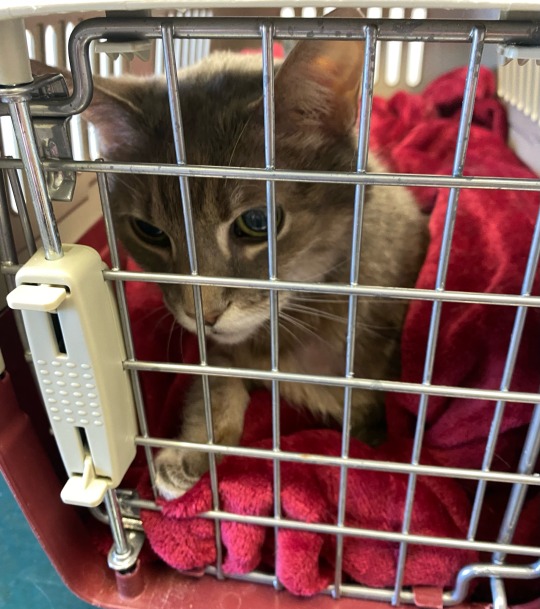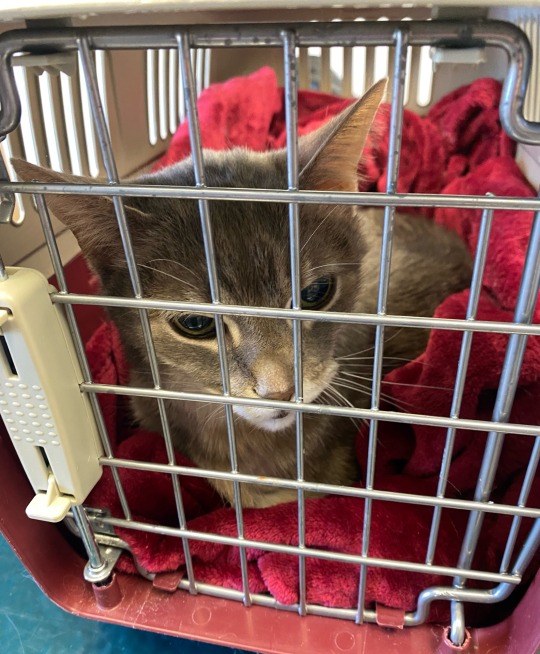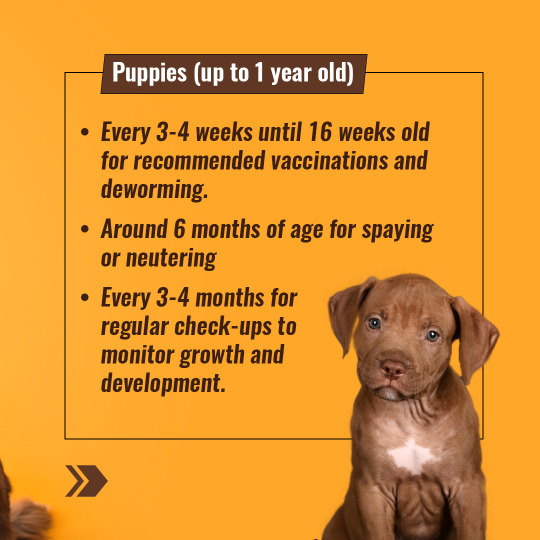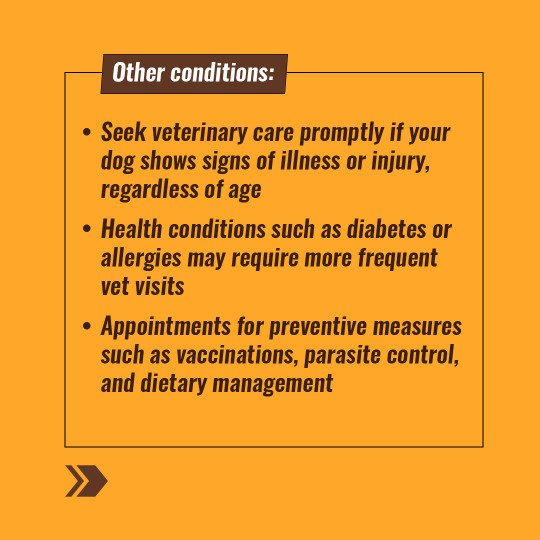#vetvisit
Explore tagged Tumblr posts
Text



Although not a fan of kitty jail, Silver takes some relief from his carrier having a skylight exit. He just started losing clumps of fur on his shoulder, so it was time for a check-up. Apparently both hyperthyroidism AND the medication they prescribe to treat it can cause alopecia (hair loss). The vet gave him a shot of Silencia for his osteoarthritis and rechecked his thyroid levels. Waiting for results and hoping this shot will give him a little more spring in his step🤞🏻He will turn 20 years old on May 9th 😻🍤🥳🎈
4 notes
·
View notes
Text
Benefits of At-Home Veterinary Services
Tailsway is revolutionizing pet care with its innovative concept of providing vet visit at home services, ensuring that both pets and their owners experience the utmost convenience in healthcare. Imagine the comfort of your furry friend receiving a thorough check-up in the familiar surroundings of home, free from the stress and anxiety often associated with clinic visits. Tailsway employs a team of highly qualified veterinarians who are not only skilled in their practice but also deeply passionate about animal welfare.
0 notes
Text

Knowing when to take your pet to the vet is crucial for their health and well-being. In this video, we discuss the key signs and situations that indicate it's time for a vet visit. From routine check-ups to unexpected symptoms, we'll guide you on how to ensure your furry friend's health is always a top priority. Whether you're a new pet owner or experienced, this video will help you stay informed and prepared. Watch now to keep your pet happy and healthy
#PetCare#VetVisit#PetHealth#PetWellness#AnimalCare#VeterinaryAdvice#HealthyPets#PetOwnerTips#FurryFriends#doglover#petcareexpert#petsdevotee#trendingvideo#newvideo
0 notes
Text
instagram
Whether it is a dental checkup or treatment for an illness of your pet? Without any delay, contact sanam veterinary care . Our specialists will strive to have the happiest and longest smiles on your favorites. For more visit www.sanam.qa.
#PetDentalCare#BrightSmiles#SanamVetCare#PetHealth#VeterinaryCare#HappyPets#PetWellness#TopVetCare#HealthyPets#PetCarePros#PetParents#FurryFriends#VetVisit#PetClinic#Instagram
0 notes
Text

https://petswellness.store/
0 notes
Text






From tiny paws to big woofs, puppies need frequent vet checkups!
Find out the perfect Vet Visit Schedule for your furry friend at Every Stage of Life.
Follow now: @budgetpetcare
#VetVisits#PuppyHealth#AdultDogCare#SeniorDogTips#PetWellness#DogCheckup#VetSchedule#budgetpetcare#DogLovers
0 notes
Text
Where Do Dogs Get Ear Mites?

Introduction Ear mites are tiny, irritating parasites that thrive in the warm, moist environment of a dog's ear canal. These microscopic invaders can cause significant discomfort and potential health issues if not addressed promptly. Understanding where dogs contract these mites is essential for prevention and ensuring the well-being of our canine companions. Key Takeaways: Where Do Dogs Get Ear Mites? - Ear mites, scientifically known as Otodectes cynotis, are tiny parasites that feed on ear wax and oils in dogs. - Dogs can contract ear mites through direct contact with an infected animal or contaminated environments. - Regular vet check-ups are essential for early detection and treatment of ear mites. - Ear mites can lead to complications like ear infections, damage to the ear canal, and hearing loss if untreated. - Dog breeds with long, floppy ears, such as Basset Hounds and Cocker Spaniels, are more susceptible to ear mites. - Ear mites thrive in environments where multiple pets coexist, like shelters and kennels. - Regular ear cleaning and maintaining a clean living environment are crucial preventive measures against ear mites. - Both over-the-counter and prescription treatments are available to combat ear mite infestations in dogs.
Understanding Ear Mites in Dogs

When discussing the overall health of your canine companion, attention should be evenly distributed between major concerns like diet and physical activity as well as minor yet critical issues like ear mites. Despite their succint nature, ear mites pose a significant threat and can lead to substantial discomfort and potential damage if not handled delicately and promptly. Left unchecked, a simple ear mite infection can spiral into substantial damage, including inflammation, hearing loss, and the inevitable stress stemming from incessant irritation. Therefore, a basic understanding of ear mites, their causes, detection, and subsequent treatment, remains a vital component of comprehensive dog care. Ear mites, scientifically known as Otodectes cynotis, are tiny, eight-legged parasites that primarily inhabit the ears of dogs, feeding on the ear wax and the oils present there. While they are microscopic and hence, invisible to the naked eye, the devastation they cause is far more tangible. Dogs of all breeds and ages can be affected by ear mites, although the infection is far more common among outdoor dogs and those in contact with an infected animal. A dog’s typical response to ear mites is excessive shaking of the head and scratching of the ears – a sign that no pet owner should ignore. Subsequent sections of this article delve deeper into the causes of ear mite infestation in dogs, the life cycle of ear mites, and the common symptoms, providing a rounded perspective to help pet owners recognize and address these pesky invaders swiftly.
The Basics of Ear Mites

Ear mites in dogs are tiny spider-like parasitic creatures that reside in the ears of pets, predominantly dogs. The mite species most commonly associated with canine ear infections is Otodectes cynotis. An ear mite infestation often leads to an inflammatory condition commonly termed 'otitis externa'. The parasites thrive on the wax and oils present in a dog's ear canal, where they can produce significant discomfort and pain to the host dog. Ear mites are highly contagious, often passed from pet to pet in close contact scenarios, especially in crowded environments such as kennels or multi-pet households. When it comes to their physical appearance, ear mites are microscopic creatures, making direct viewing impossible without the aid of a microscope. Their tiny, pale bodies feature eight legs, a relatively short lifespan, and quite an impressive reproduction rate. A single mite can live up to two months during which it undergoes a complete life cycle from egg to adult, laying eggs repeatedly. This rapid turnaround can escalate a mild infestation to a severe one in a very short time period, resulting in a range of health complications for the affected dog, from simple ear irritation to more severe conditions like skin infections.
Causes of Ear Mite Infestation in Dogs

Ear mites in dogs are typically caused by a type of arachnid named Otodectes cynotis. These mites are diminutive and barely visible to the human eye; however, their small size doesn't prevent them from causing significant discomfort to dogs. They find a hospitable environment in the warm, moist surroundings of a dog's ear canal, also their most frequent inhabitat, leading to a condition known as otodectic mange. They thrive, breed, and lay eggs in these circumstances, causing your dog much distress and leading to skin inflammation and ear infections if not promptly treated. But, how does a dog contract ear mites? Ear mites are highly transmissible, usually spread through the close physical contact between infected and non-infected animals. More notably, kittens and young puppies contract ear mites through their mother during the nursing period, leading to early-age infestation. Furthermore, dogs who spend more time outside or are frequently in environments with many other animals, such as kennels or pet shops, are more susceptible to ear mites. It's vital to remember that the likelihood of an ear mite infestation increases when dogs are exposed to unclean or parasite-infested environments. Thus, maintaining a healthy, clean living situation for your dog will significantly reduce their chances of contracting these irksome pests.
Common Breeds Prone to Ear Mites

Dog breeds with long, floppy ears are generally more susceptible to ear mites. Breeds such as Basset Hounds, Cocker Spaniels, and Beagles, with their characteristic large, droopy ears, provide an ideal, dark and warm environment for these parasites. Given the structure of their ears, these breeds often experience limited air circulation which leads to increased humidity within the ear canal - conditions that favor the proliferation of ear mites. However, ear mites can infest dogs of any breed, so it's crucial to remember that every dog is potentially at risk. The anatomy of some dog breeds makes them prone to ear mite infestations. Breeds such as Poodles and Schnauzers, known for their dense ear hair, are also susceptible as the hair can trap debris, wax, and moisture within the ear, providing a hospitable environment for ear mites. It is the owner's responsibility to ensure routine ear health checks, irrespective of the breed of the dog. Regular grooming, specifically trimming of excess ear hair and cleaning of ears, can help in early detection and prevention of ear mite infestations in these breeds.
Typical Environments for Ear Mite Infestation

Ear mites thrive in various environments. However, they are typically associated with locations where multiple pets coexist, such as shelters, kennels, or homes with multiple fur inhabitants. Such spaces provide a simple pathway for ear mites to change hosts frequently and rapidly. While mites are capable of surviving without a host for short periods, a dense gathering of potential hosts creates a favorable environment for their reproduction and survival. Moreover, environments with poor hygiene or lack of regular cleaning schedules can easily become breeding grounds for ear mites. There are also concerns regarding outdoor environments. Dogs who frequent outdoor areas that have wildlife animals such as feral cats, rabbits, or foxes, are at a higher risk of contracting ear mites. These wild animals are usually carriers of ear mites and an infestation can easily be picked up by your curious pup. Additionally, warmer and humid climates are highly conducive to ear mite proliferation. Mites thrive in such conditions, increasing the chances of infestation in your furry companion. Though no specific place guarantees safety from ear mites, understanding where they prosper helps implement strategic preventive measures.
How Dogs Contract Ear Mites

Ear mites are tiny parasites that commonly infest the ears of pets, particularly dogs. They can cause a significant amount of discomfort for a dog and also be a source of concern for pet owners. Understanding how they are transmitted can be key in implementing preventive measures. One of the most common ways dogs become infested with ear mites is through direct contact with an infected animal. These parasites are highly contagious and can easily spread from one host to another. If a dog is in close proximity or shares a living space with an infested pet, it is highly likely that it will also get ear mites. Even brief encounters with infested animals at places like dog parks or kennels can lead to a dog contracting ear mites. Beyond direct contact, ear mites can spread in a variety of indirect ways. For instance, a dog can become infested by exposure to a contaminated environment. Mites are capable of surviving for a short period without a host and can reside in bedding, carpets, and furniture. If an infested animal has been in these environments, the mites can linger and potentially infect a dog that subsequently comes into contact with the contaminated area. Ear mites can also be passed on from a mother to her puppies. This is often the case with puppies that are born to a mother who has an active ear mite infestation. The close contact and shared living space make it easy for the mites to migrate from the mother to her puppies. Despite this tendency, it is important to note that infestation is not solely a concern for young dogs; dogs of any age are susceptible to contracting ear mites. The scenario is worsened when dogs have compromised immunity due to other health conditions, making them more vulnerable to developing a severe infestation. Similarly, dogs with long, floppy or hairy ears like Basset Hounds, Cocker Spaniels, or Poodles are more prone to contracting ear mites due to their ear structure, which creates a warm, moist environment – ideal for mites to thrive. Understanding how ear mites spread can help dog owners prevent a potential infestation. With knowledge of the common risk factors, it becomes easier to devise effective strategies to protect your dog. These may include regular vet check-ups, proper hygiene, reducing contact with infested animals, and maintaining a clean living environment. Treatment at the first sign of infestation is also necessary to interrupt the spreading of mites to other pets and areas in the house. With the right preventive measures and timely treatment, ear mites can be effectively managed to ensure the dog’s comfort and well-being.
Ear Mite Life Cycle in Dogs

The life cycle of ear mites in dogs is a dynamic process that involves multiple stages. Beginning as eggs laid in the ear canal or on the surrounding hair, these parasites mature into adults in a span of three weeks. The eggs hatch after four days into larvae. This larval stage lasts for about a week and during this period, they feed on the ear wax and skin oils. Upon reaching the nymph stage, mites undergo two substages, known as protonymph and deutonymph, before finally growing into adult mites. During each of these stages, they continue to feed on the skin debris and oils in the dog's ear. This uninterrupted feeding process often causes inflammation and discomfort to the host. Adult ear mites, once fully grown, are capable of reproduction, giving rise to a new generation of parasites, thereby perpetuating the lifecycle. It's important to note that the entire life cycle of an ear mite takes place on the dog, making these parasites tricky to deal with, and hard to eliminate completely. Understanding this cycle can help in effective treatment and preventive measures.
The Connection Between Fleas and Ear Mites

Though not necessarily linked, fleas and ear mites can strike a distressing double blow to your pet's wellness. Both are external parasites that feed on hosts like dogs and cats, causing discomfort, as well as potential health issues if not addressed promptly. Their presence often prompts excessive scratching, which can lead to secondary infections. However, their similarities don't end at symptoms; understanding their parallels further might aid in the better management and prevention of both infestations. At times, a dog already plagued with fleas could be more prone to ear mite infestation, and vice versa. During grooming, when a dog might use its flea-infested paws to scratch at itchy ears, mites could be transported to the ear canal. Furthermore, fleas and ear mites also prefer similar environments - warm, hidden spaces on the body of a host. A dog's ear, with its delicate balance of warmth and moisture, is an excellent breeding ground for ear mites, much like how the thick fur coats provide cozy homes for fleas. Recognizing these commonalities could greatly assist in treating these parasitic issues and preventing them from reoccurring.
Recognizing Symptoms of Ear Mites in Dogs

The recognition of ear mites in dogs begins by observing certain changes in your pet’s behavior and physical state. Your pet may repeatedly scratch or shake their head, causing further irritation and increasing the risk of ear damage. Also, an infested dog may rub its ears on various surfaces including furniture and carpet, in an attempt to relieve itching. Dogs with ear mites often possess ears that are red, inflamed, and sore to the touch. The incessant scratching may lead to crusting and scaling around the ears which can potentially provide a site for secondary bacterial infections. The hallmark sign of ear mites, however, is a black or brownish discharge present within the ear canal, often resembling coffee grounds. This discharge is made up predominantly of the ear mites themselves, their waste, and the skin debris. An unpleasant odor from the dog’s ears may also signal the presence of an ear mite infestation. If these signs are noted, it’s important to take your pet to the vet promptly for a professional examination as ear mites can cause serious complications if left untreated. Additionally, look out for changes in your dog’s behavior such as a lack of appetite, irritability, or a decrease in activity level which could indicate discomfort or pain associated with the mite infestation.
Diagnosing Ear Mites in Dogs

When a dog constantly scratches its ears or shakes its head, the possibility of an ear mite infestation becomes likely. Ear mites are tiny, irritating parasites that find comfort in the warm, moist environment of a dog's ear canal. For a concerned pet owner, seeking expert help to confirm the presence of ear mites is crucial. Veterinarians can provide a definitive diagnosis and subsequently prescribe an effective treatment plan. Read the full article
#canineearcare#dogearhealth#dogearinfections#doggrooming#earmitecauses#earmiteinfestation#earmitelifecycle#earmiteprevention#earmitesymptoms#earmitetransmission#earmitetreatment#otitisexterna#pethygiene#vetvisits#WhereDoDogsGetEarMites
0 notes
Link
0 notes
Text



@dianysaurusrex - Just chaos posting to match my heartbreak energy. Hug your loves close while you can. ❤️❤️ #adoptDontShop #FurBaby #maincoonstagram #maincoon #VetVisit
3 notes
·
View notes
Video
youtube
Family Friendly New Adventure🐶 OUCH! Chesco's Head Bump & Vet Visit! 🏥@i...
Family Friendly New Adventure🐶 OUCH! Chesco's Head Bump & Vet Visit! 🏥 @insta360 #ph #ita 🇵🇭❤️🇮🇹 Chesco's Playtime Mishap! 🤕 Poor pup bumped his head while playing with the dogs. We rushed to Dr. Angos Medical Center for a quick check-up and vaccination. Join us as we navigate the vet visit, share some laughs, and hopefully, a speedy recovery for our furry friend! #Chesco #DogLover #VetVisit #PuppyLove #DogsofInstagram insta360 insta360 x4 insta360 x3 @insta360
0 notes
Text
Terrible cats day🙀 Scarry trip to the vet clinic 🧑⚕️🚘 #veterinary #scary #scarycat #VetVisit
New Post has been published on https://petn.ws/4kG3x
Terrible cats day🙀 Scarry trip to the vet clinic 🧑⚕️🚘 #veterinary #scary #scarycat #VetVisit
Join us on an exciting journey into the world of feline adventures. Meet Asya – a lively and playful cat who adores spending time playing and goofing around with her favorite toys at home. Every day for her is a celebration, filled with joy and satisfaction. 🐱🎉 #CatLife #PlayfulKitty #FelineAdventures But one day, her ordinary […]
See full article at https://petn.ws/4kG3x #HilariousCatVideos
0 notes
Text
ABOUT SANAM VETERINARY HOSPITAL
The best veterinary clinic near doha and Pharmacies in Qatar. The cheapest vet in qatar. Awarded by government veterinary clinic in qatar.
Specialized veterinary clinic and pharmacy, established on 2017 providing services for pets and large animals also have veterinary laboratory supplied with latest equipment’s.
Currently, we have our Hospital providing pets surgery, grooming, cat boarding and more services located in Rawdat Al Khail Street, Al Hilal.
Apart from this we opened three pharmacy branches especially for large animal like camel, horse, cow, sheep, goat, etc. located at Muaither, Ash-Sheehaniya and Sawda Natheel.
The company has acquired customer confidence within this short term, and we are the distributor of almost veterinary medicine companies in Middle East and exclusive agent for ZOOVET Company.
The company managed within two years for opening three branches further the main branch as well, and aspiring of expansion in the field of veterinary clinics and veterinary pharmacy and opening new branches at the future, the assets of company increased and became $ 1,500,000 (one million five hundred thousand dollars).
#PetHealth#VeterinaryCare#HappyPets#PetWellness#TopVetCare#HealthyPets#PetCarePros#PetParents#FurryFriends#VetVisit#PetClinic#SanamVetCareTips#AnimalCare#PetSupport#SafeSpaceForPets#DohaVetClinic#PetWellbeing#LoveYourPet#BalancedDiet#PetTips#VetGuidance#SanamQatar#PetHealth101#ExpertPetCare
1 note
·
View note
Text
The past few weeks this sweet little guy #MelloTheStudioCat has been in and out of the vet, as well as my dog Fongito, who just turned 10 a couple weeks ago... Poor fluffernutters! Theyre both gonna be ok though, eventually, with some more treatments and visits. A song for all who breathe through today and for all those who have lost thier breath, a song for today, for love, strength, courage, compassion. #Zeratha_Lotussoul_Studios #MelloTheStudioCat #FongitoTheShadowDog #fluffernutters #persialayan #Frenchbo #vetvisits #equanimous #iamalcina
via IFTTT
View On WordPress
0 notes
Text
0 notes
Photo

The pups had their teeth cleaned today and the vet gave them a present. I can't tell if it's touching or mocking. #vetvisit #dogsofinstagram #adoptdontshop #maltese (at Tarpon Springs, Florida) https://www.instagram.com/p/CNllfjgDnFD/?igshid=hcynxt8j5wew
1 note
·
View note